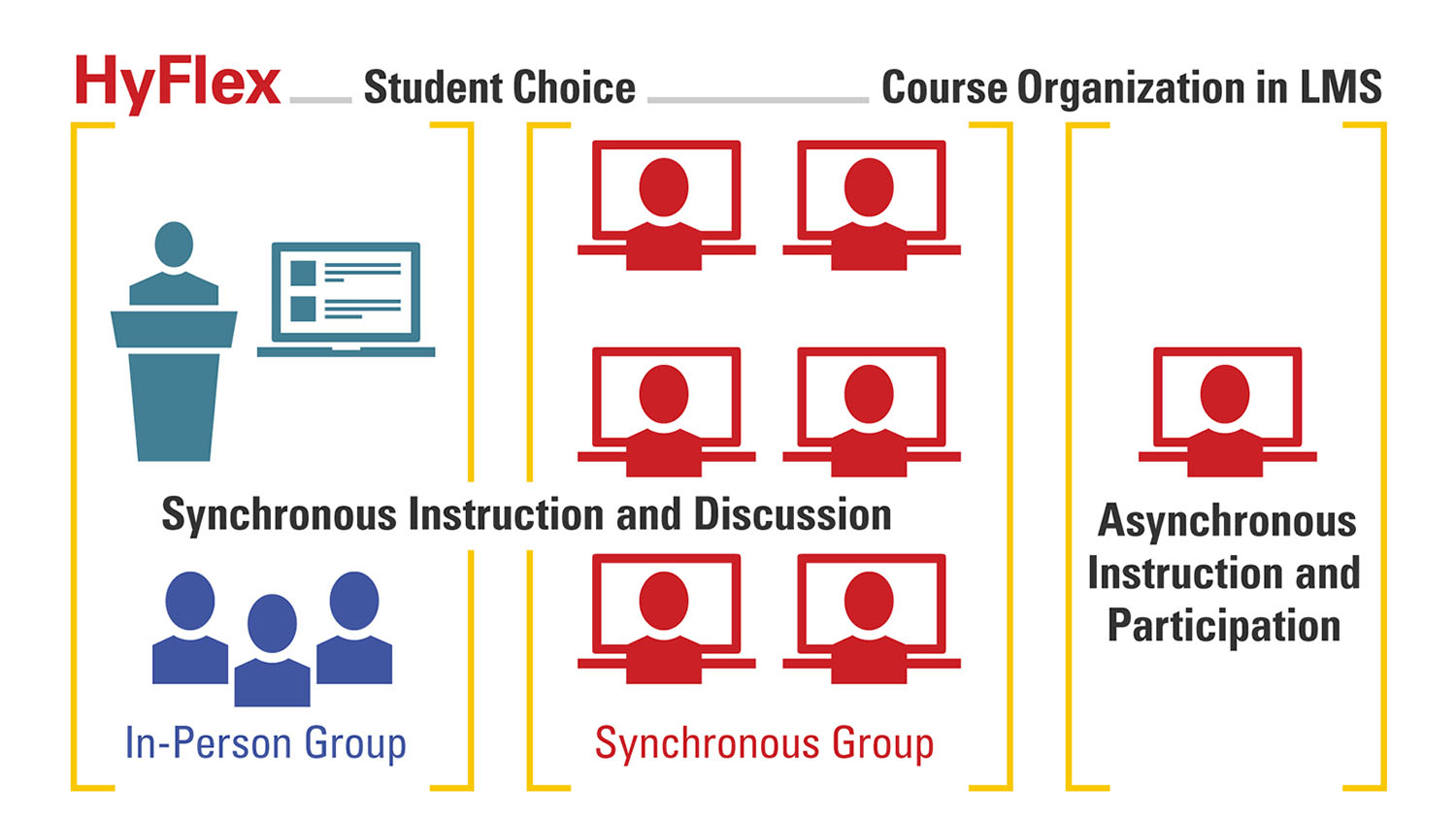Faculty Fellows Series: Perspectives from a HyFlex Classroom


Many instructors have wanted to provide flexibility for students in the way that they interact and participate in class. A course design format called HyFlex, short for Hybrid-Flexible, offers students the choice to participate in-person, online synchronously or online asynchronously.
This series of articles from our DELTA Faculty Fellows will explore the ways that they have implemented HyFlex this semester across a variety of subjects.
The first in this series will feature Sarah Khan, teaching associate professor in the Poole College of Management.
Background
I am teaching two classes (4 sections) in Fall 2021. The first of these is BUS 340 Information Systems Management. This is a course with large enrollment, about 600 students per semester with about six to eight sections offered.
This course was the recipient of a DELTA Grant to be redesigned as a hybrid course using a flipped approach. During COVID-19, we were able to move this class easily online. During this transition, students would meet once a week synchronously with the instructor, instead of in person. In Fall 2021, this course is now available as a hybrid option to the students.
BUS 444 (Systems Analysis and Design) is a senior-level course with multiple sections (about 70 students in total). This course was designed to be offered as traditional in-class instruction. During COVID-19, I had to redesign this course to be offered online without compromising its quality. It was challenging since this is an applied technical course requiring problem-solving during class sessions and access to lab tools. I chose to convert this course into an online hybrid design (one synchronous meeting a week) with a flipped approach (prep materials provided to the students before the live class session in an asynchronous manner). I moved the tool needed for this class to the NC State virtual computing lab with the help of NC State OIT, along with providing an open-source option to the students if possible. In Fall 2021, this course is available as an in-person class to the students and it still uses the flipped design.
HyFlex Motivation
At the beginning of Fall 2021, I didn’t intend to use HyFlex design for either of my classes. None of the classes require mandatory attendance and all class recordings are available via Panopto after each session. Within a few weeks of the semester, students started reaching out about their inability to attend classes in person, for several reasons. In addition, there was another group of students who wanted to interact with the instructor and fellow students during live sessions to improve their understanding of the topic under discussion. These needs in both my classes motivated me to explore the HyFlex option and implement it without disrupting the flow of the class.
BUS 340 HyFlex Course Design and Delivery
All students have a weekly learning cycle, divided into three sections: before-class preparation, in-class learning, and after-class learning. There is only one class meeting per week. Before class preparation utilizes the flipped approach principles to help students get accustomed to the basics of the topic under discussion for that week.
They are required to complete certain tasks such as watching videos, completing and/or submitting homework. Students have access to help via the online discussion forum Piazza, TAs and the instructor. Students are encouraged to use the online forum as much as possible.
In-class learning is where students tackle a problem collaboratively for which they prepared beforehand. Before HyFlex design, only the students who could attend class in person could experience collaborative learning. After switching to HyFlex design, all students could join the class session via Zoom link. Attendance is not mandatory, however, it allows students to participate during class. Here is a general protocol followed during the class session:
- I initiate the Zoom session using the Zoom link on Moodle and connect my laptop to the class AV system. Students in the class can see my screen on the projector.
- Students join the class either in-person or via Zoom. I have set up my Zoom session with the waiting room enabled and I let students in when it’s time. Students are muted when they enter the Zoom session. They are not required to have their camera on.
- I spend about two minutes on the soundcheck for all students.
- I enable my desktop share on Zoom which is viewable to all students. I do not have my camera on during the class to allow the full desktop capture during class recording.
- During the class session, students attending the class in person are encouraged to join via Zoom to work with their classmates.
- I encourage students attending class via Zoom to use Zoom Chat to post any questions. Students are encouraged to answer each other’s questions irrespective of their attendance mode.
- The class session is also recorded and made available for later view on Panopto. I control the recording of the class session to ensure the relevant parts of the class are recorded. That saves my time on post-production of these recordings.
After class learning consists of practice problem sets, self-reflection and topic review.
Students again have access to help via the online discussion forum Piazza, TAs and the instructor.
BUS 444 HyFlex Course Design and Delivery
All students have a weekly learning cycle, divided into three sections: before-class preparation, in-class learning, and after-class learning. There are two class meetings per week, and the students typically prepare for both sessions in their before-class preparation.
Similar to BUS 340, before-class preparation in this course utilizes the flipped approach principles to help students get accustomed to the basics of the topic under discussion for that week’s lesson. They are required to complete certain tasks such as reading, watching videos, completing self-administered quizzes and/or submitting homework. Students have access to help via the online discussion forum Piazza, which is monitored by the TAs and the instructor. Students are encouraged to use the online forum as much as possible.
During in-class learning, the concept under discussion is allied in a real-world scenario. Before HyFlex design, students relied on post-class recordings to catch up with the materials. After switching to HyFlex design, students could join the class session via Zoom link. Attendance is not mandatory, however, it allows students to participate during class. My general protocol for this class is similar to BUS 340, with some minor modifications:
- I encourage students attending class via Zoom to use Zoom Chat to post any questions. I assign at least one in-person student present in the class to monitor the chat in case I miss answering a question posted. Students are encouraged to answer each other’s questions irrespective of their attendance mode.
- If we have a graded class participation exercise planned that day, I require everyone to join the Zoom session and we use breakout rooms for random team assignments. In-person students share their feedback by speaking up in the class which is audible to the students attending the session via Zoom. Students attending the class via Zoom raise their hands first before I allow them to unmute and share their feedback. They are audible to the rest of the students since my laptop that is running Zoom is connected to the class AV system.
- Students are guided to use cloud-based collaboration tools during class participation work such as Lucid Charts, Google Drive tools, etc.
- The class session is also recorded and made available for later view on Panopto. I control the recording of the class session to ensure the relevant parts of the class are recorded. That saves my time on post-production of these recordings.
All the exams are administered in person. Students who are not able to join in person are rescheduled to take the exam via Zoom. They are required to have their screen share enabled during the exam session and their exam session is recorded. Since I have very few students who cannot come to take the exam in person, this method is working.
Moving Forward
So far, I have found this move to HyFlex beneficial. However, this is just my intuition based on attendance during class sessions. I intend to conduct a brief survey at the end of the semester in both classes to get students’ feedback on this method and see how to make better use of this format.



